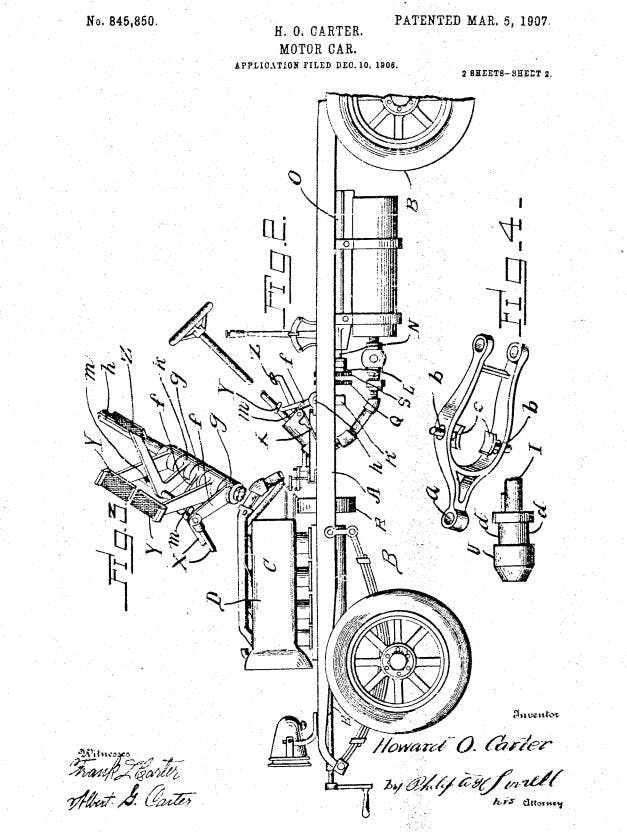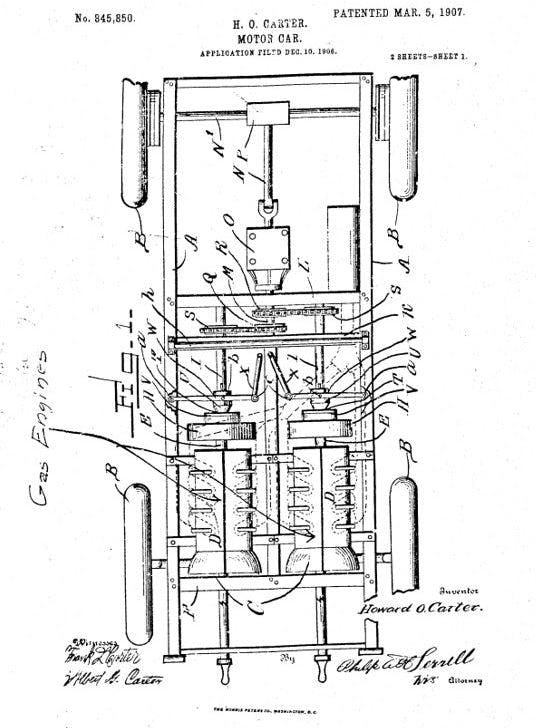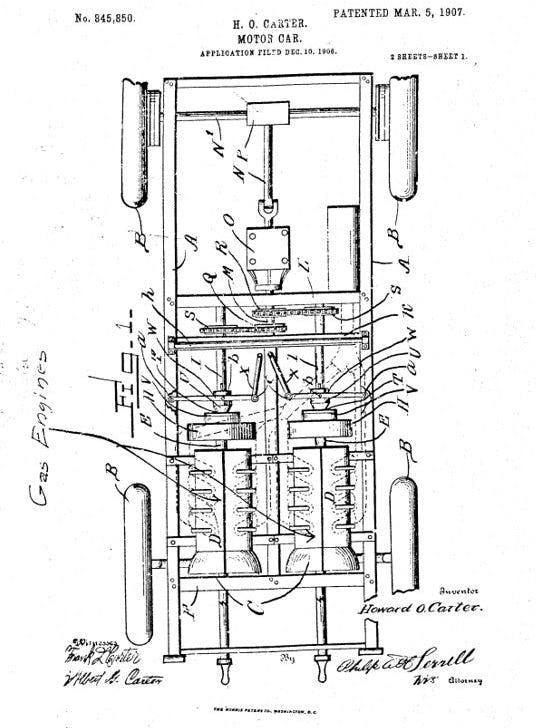Media | Articles
Are two engines better than one? In 1907, Howard Carter thought so
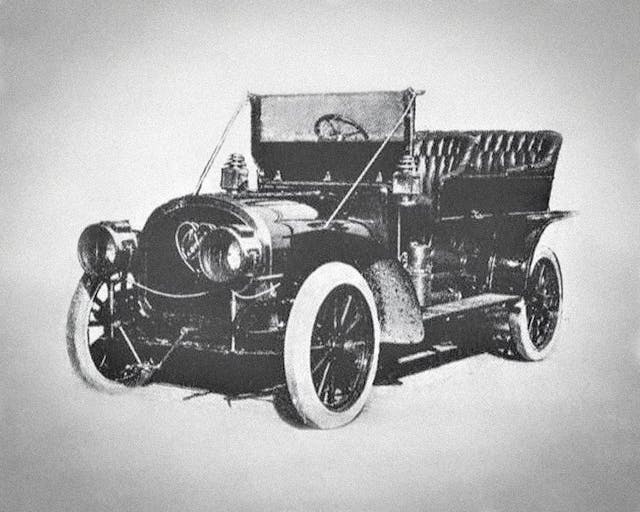
If two heads are better than one, so are two engines. That was the philosophy of Howard O. Carter, who at the turn of the 20th century bet his reputation on it—and shed some blood in the process.
In 1907, Carter filed a patent application for a two-engine car. The side-by-side four-cylinder, air-cooled engines could be used individually or in conjunction “through cone clutches in the flywheels and by Morse silent chains, to a single three-speed transmission placed in the center of the car,” according to a 1907 story in the Scientific American. Carter reasoned that the setup would ensure safe passage in case of breakdown in a remote area. Claiming his newfangled Carter Two-Engine Car offered “two hearts that beat as one,” a motto reflected in the company’s double-heart logo, Carter began accepting orders while simultaneously selling stock in the Carter Motor Car Corporation.
Advertising for the Washington, D.C.-based Carter Two-Engine—not to be confused with the Michigan-built Carter Car that came later—called it “the only reliable, economical, and speedy car—BAR NONE. Equipped with two four-cylinder independent gasoline engines. Pronounced by experts (as) absolutely perfect, a ‘tow home’ unknown.”
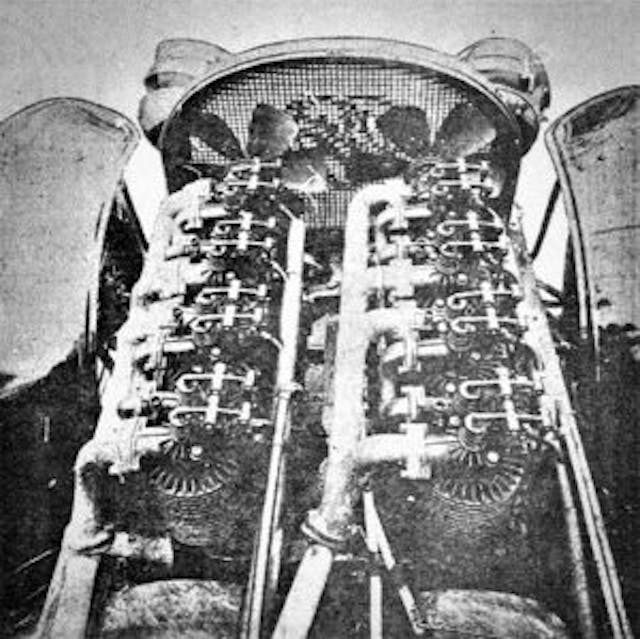
The Carter Two-Engine Car was offered in three forms: convertible, gentleman’s roadster, and touring car. Advertising for the “Model A” claimed the air-cooled engines combined for 40 horsepower. According to a more recent story in the Scientific American, each engine had its own ignition, carburetor, lubrication, radiator, and clutch. “There was an additional foot pedal for the second motor, which was placed next to the first so that both could be engaged or disengaged with one foot movement. Each engine was held in place by four bolts, so that if it needed to be repaired it could be removed and the car would still run by using only the remaining engine.”
Six weeks after Carter’s patent had been granted, he proved the value of a backup engine—by accident. According to the April 23 edition of the Washington Evening Star, Carter stopped to assist another driver, whose car had broken down near Detroit. Carter was fiddling with the crank when it jerked violently and struck him in the face, breaking his jaw and leaving him badly bloodied. Carter even had to have part of his cheekbone removed, and he was hospitalized for a time while his brother ran the company.
Marketplace
Buy and sell classics with confidence
While Howard Carter recovered, the vultures began to circle. He refused to give in. In an open letter to stockholders printed in The Washington Post on August 11, 1907, he spoke of “an abundance of adverse criticism, principally among my acquaintances, many of whom I thought possessed superior judgment. They went so far as to say that I was insane, that I was throwing my money away, that the car built after my ideas would not work, that each engine would be fighting the other, and many other comments I often recall and that are now exceedingly amusing and laughable.
“Continually bearing such adverse decisions, I several times thought very strongly of abandoning the idea, that I was wrong somewhere or somehow sidetracked in attempting to accomplish the impossible. But on second thought, knowing that the [other] automobiles as palmed off upon the purchasing public were far from being reliable, especially when distant from the repair shop, often necessitating a long wait for parts to be shipped from the factory, I decided to keep at my idea.”
Carter did not stop there. He was so confident in his invention that he finished the letter by making bold predictions that would never come to pass. “Before leaving for Detroit, I wish to make a positive statement and predict that the Carter Motor Car Corporation within two years’ time will have an output of 20,000 cars annually of all kinds, that within five years’ time the annual output will be 50,000 cars, that within 10 years’ time our Eastern plant at Hyattsville, Maryland, will be the largest automobile manufacturing concern in the world, with an annual capacity of 100,000 cars.”
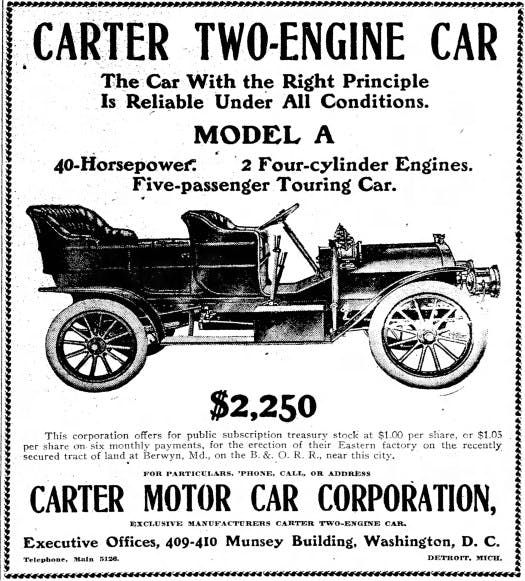
Research has not revealed actual production numbers, but it’s likely that few Carter Two-Engine Cars were produced from 1907 to 1908, when the business was shuttered. The few available images of the car and its engine comes from newspapers or magazines of the era.
Although Carter’s idea had its merits, certainly in an era when mechanical breakdowns were far more common, the high cost of the car limited its availability to most Americans. Starting at $2250—about $65K today—it was nearly three times the price of a Model T, which could be had for $825.
Unable to justify the cost, buyers ultimately decided that two engines are, in fact, not better than one.
